Finance for Enterprise - Pricing Methods Report for Royal Dutch Shell
VerifiedAdded on 2022/09/01
|8
|2140
|20
Report
AI Summary
This report examines the pricing strategies employed by Royal Dutch Shell, a major player in the oil and gas industry. It delves into various pricing methods, including mark-up pricing, price bundling, break-even pricing, target return pricing, and early cash recovery pricing. The report provides a detailed analysis of each method's advantages and disadvantages, considering their appropriateness for Shell's business operations and product offerings, such as LNG, natural gas, petroleum, lubricants, and petrochemicals. The analysis considers market factors, cost structures, and competitive landscapes to evaluate the effectiveness of each pricing approach, offering insights into how these strategies impact the company's profitability and market share. The report also provides the advantages and disadvantages of the pricing methods, and how they can be used to set the prices of the product like LNG, natural gas, Petroleum, Lubricants, Petrochemicals, etc. and helps in evaluating the profit of the company. The report provides a comprehensive overview of pricing strategies for the company.
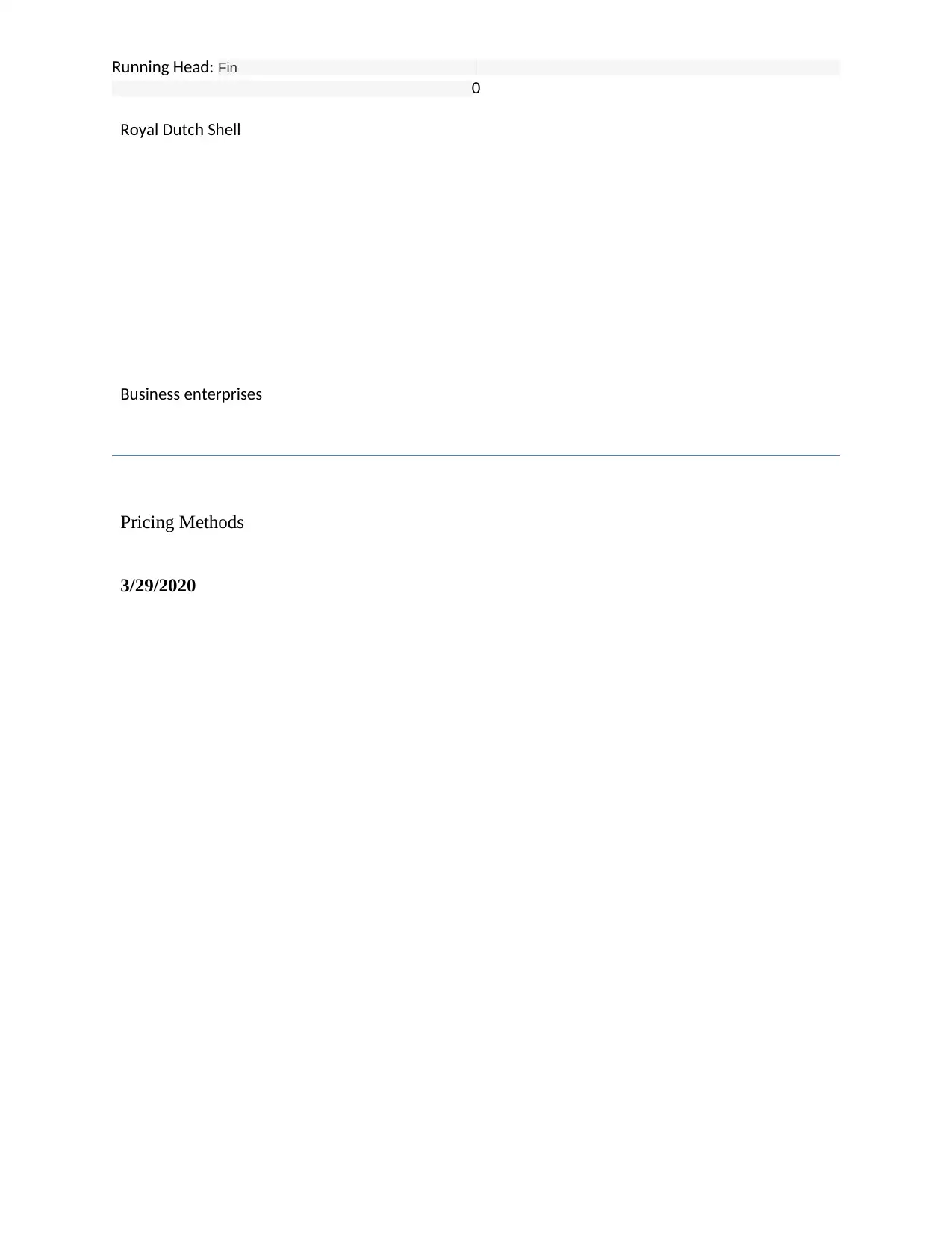
Running Head: Fin
0
Royal Dutch Shell
Business enterprises
Pricing Methods
3/29/2020
0
Royal Dutch Shell
Business enterprises
Pricing Methods
3/29/2020
Paraphrase This Document
Need a fresh take? Get an instant paraphrase of this document with our AI Paraphraser
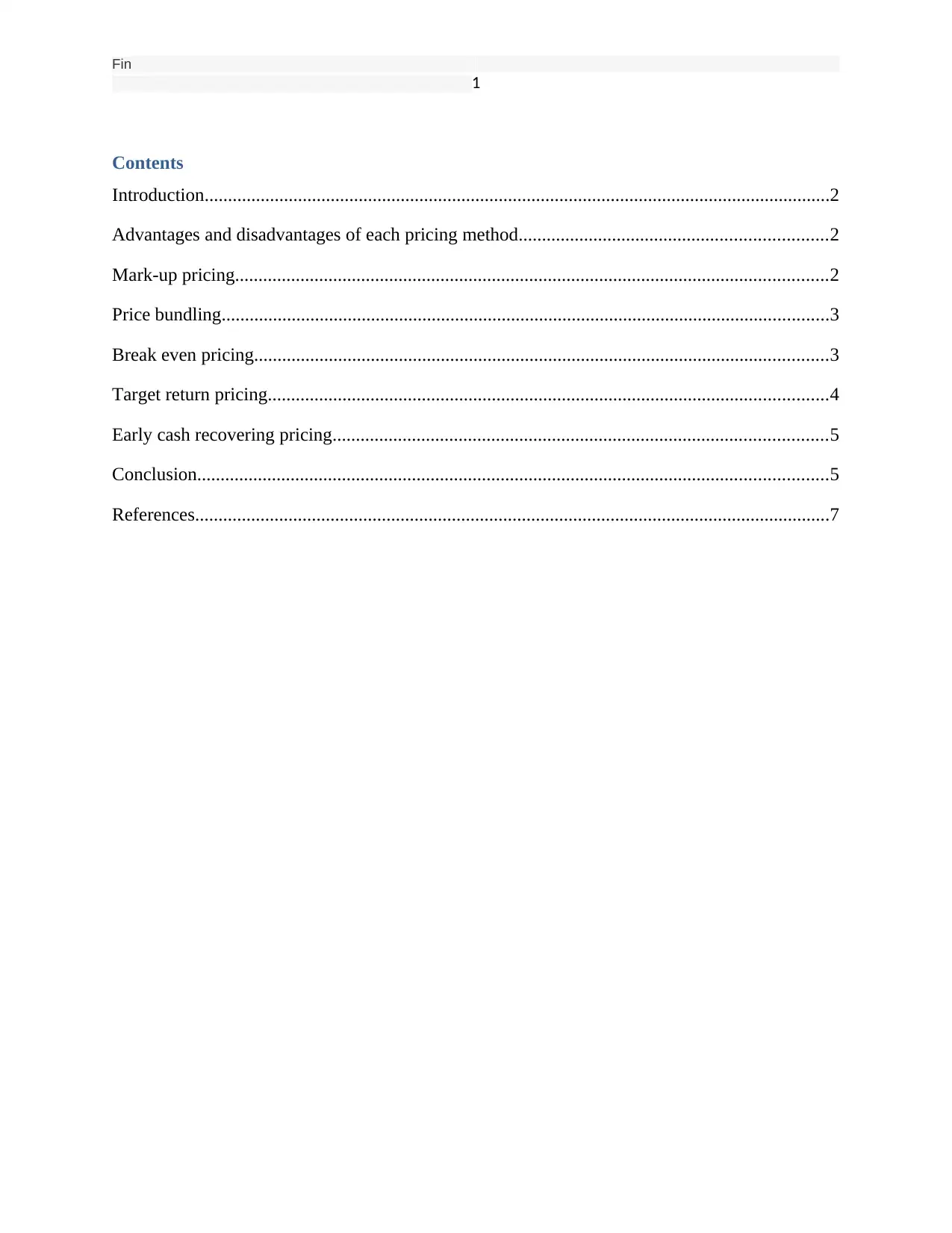
Fin
1
Contents
Introduction......................................................................................................................................2
Advantages and disadvantages of each pricing method..................................................................2
Mark-up pricing...............................................................................................................................2
Price bundling..................................................................................................................................3
Break even pricing...........................................................................................................................3
Target return pricing........................................................................................................................4
Early cash recovering pricing..........................................................................................................5
Conclusion.......................................................................................................................................5
References........................................................................................................................................7
1
Contents
Introduction......................................................................................................................................2
Advantages and disadvantages of each pricing method..................................................................2
Mark-up pricing...............................................................................................................................2
Price bundling..................................................................................................................................3
Break even pricing...........................................................................................................................3
Target return pricing........................................................................................................................4
Early cash recovering pricing..........................................................................................................5
Conclusion.......................................................................................................................................5
References........................................................................................................................................7
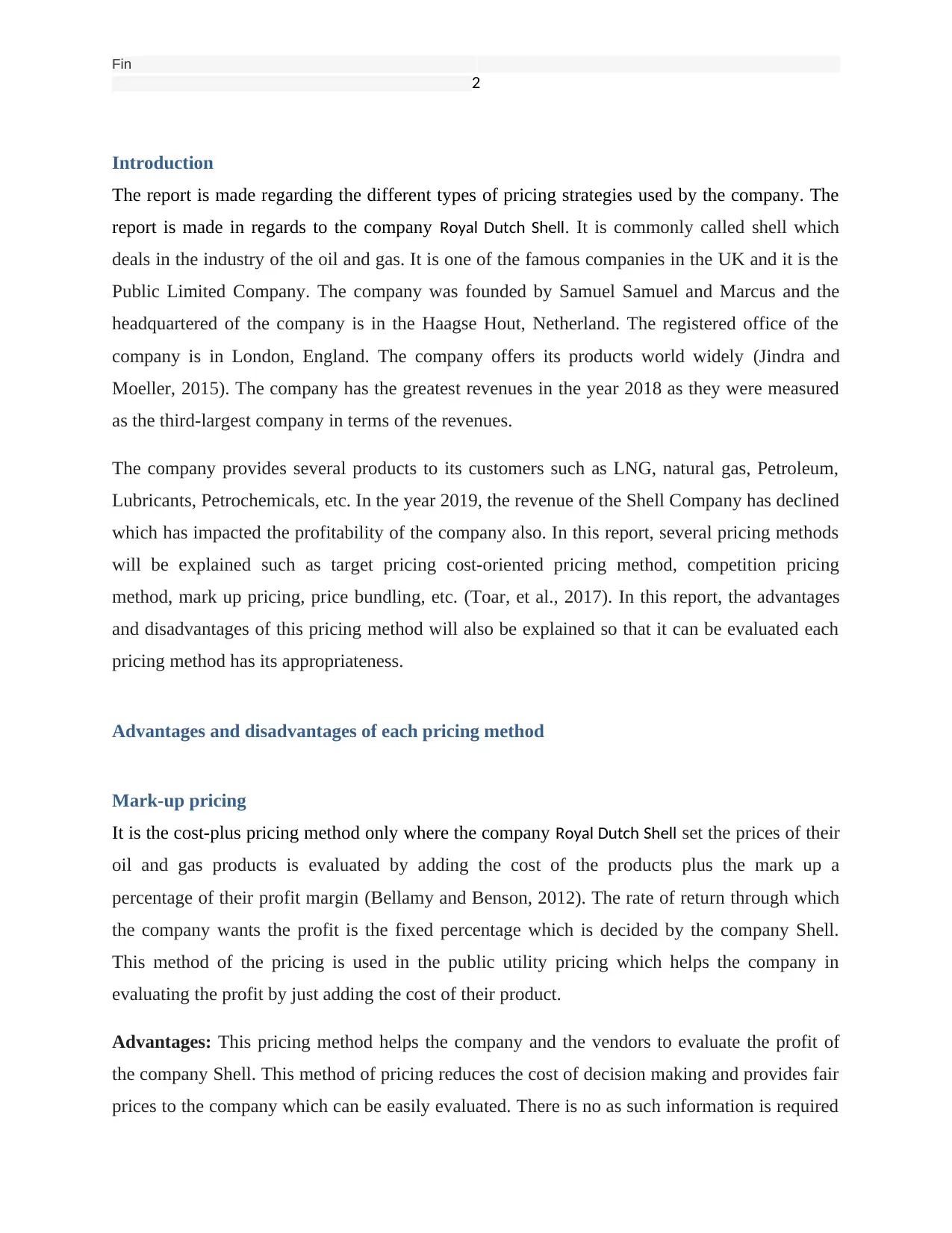
Fin
2
Introduction
The report is made regarding the different types of pricing strategies used by the company. The
report is made in regards to the company Royal Dutch Shell. It is commonly called shell which
deals in the industry of the oil and gas. It is one of the famous companies in the UK and it is the
Public Limited Company. The company was founded by Samuel Samuel and Marcus and the
headquartered of the company is in the Haagse Hout, Netherland. The registered office of the
company is in London, England. The company offers its products world widely (Jindra and
Moeller, 2015). The company has the greatest revenues in the year 2018 as they were measured
as the third-largest company in terms of the revenues.
The company provides several products to its customers such as LNG, natural gas, Petroleum,
Lubricants, Petrochemicals, etc. In the year 2019, the revenue of the Shell Company has declined
which has impacted the profitability of the company also. In this report, several pricing methods
will be explained such as target pricing cost-oriented pricing method, competition pricing
method, mark up pricing, price bundling, etc. (Toar, et al., 2017). In this report, the advantages
and disadvantages of this pricing method will also be explained so that it can be evaluated each
pricing method has its appropriateness.
Advantages and disadvantages of each pricing method
Mark-up pricing
It is the cost-plus pricing method only where the company Royal Dutch Shell set the prices of their
oil and gas products is evaluated by adding the cost of the products plus the mark up a
percentage of their profit margin (Bellamy and Benson, 2012). The rate of return through which
the company wants the profit is the fixed percentage which is decided by the company Shell.
This method of the pricing is used in the public utility pricing which helps the company in
evaluating the profit by just adding the cost of their product.
Advantages: This pricing method helps the company and the vendors to evaluate the profit of
the company Shell. This method of pricing reduces the cost of decision making and provides fair
prices to the company which can be easily evaluated. There is no as such information is required
2
Introduction
The report is made regarding the different types of pricing strategies used by the company. The
report is made in regards to the company Royal Dutch Shell. It is commonly called shell which
deals in the industry of the oil and gas. It is one of the famous companies in the UK and it is the
Public Limited Company. The company was founded by Samuel Samuel and Marcus and the
headquartered of the company is in the Haagse Hout, Netherland. The registered office of the
company is in London, England. The company offers its products world widely (Jindra and
Moeller, 2015). The company has the greatest revenues in the year 2018 as they were measured
as the third-largest company in terms of the revenues.
The company provides several products to its customers such as LNG, natural gas, Petroleum,
Lubricants, Petrochemicals, etc. In the year 2019, the revenue of the Shell Company has declined
which has impacted the profitability of the company also. In this report, several pricing methods
will be explained such as target pricing cost-oriented pricing method, competition pricing
method, mark up pricing, price bundling, etc. (Toar, et al., 2017). In this report, the advantages
and disadvantages of this pricing method will also be explained so that it can be evaluated each
pricing method has its appropriateness.
Advantages and disadvantages of each pricing method
Mark-up pricing
It is the cost-plus pricing method only where the company Royal Dutch Shell set the prices of their
oil and gas products is evaluated by adding the cost of the products plus the mark up a
percentage of their profit margin (Bellamy and Benson, 2012). The rate of return through which
the company wants the profit is the fixed percentage which is decided by the company Shell.
This method of the pricing is used in the public utility pricing which helps the company in
evaluating the profit by just adding the cost of their product.
Advantages: This pricing method helps the company and the vendors to evaluate the profit of
the company Shell. This method of pricing reduces the cost of decision making and provides fair
prices to the company which can be easily evaluated. There is no as such information is required
⊘ This is a preview!⊘
Do you want full access?
Subscribe today to unlock all pages.

Trusted by 1+ million students worldwide
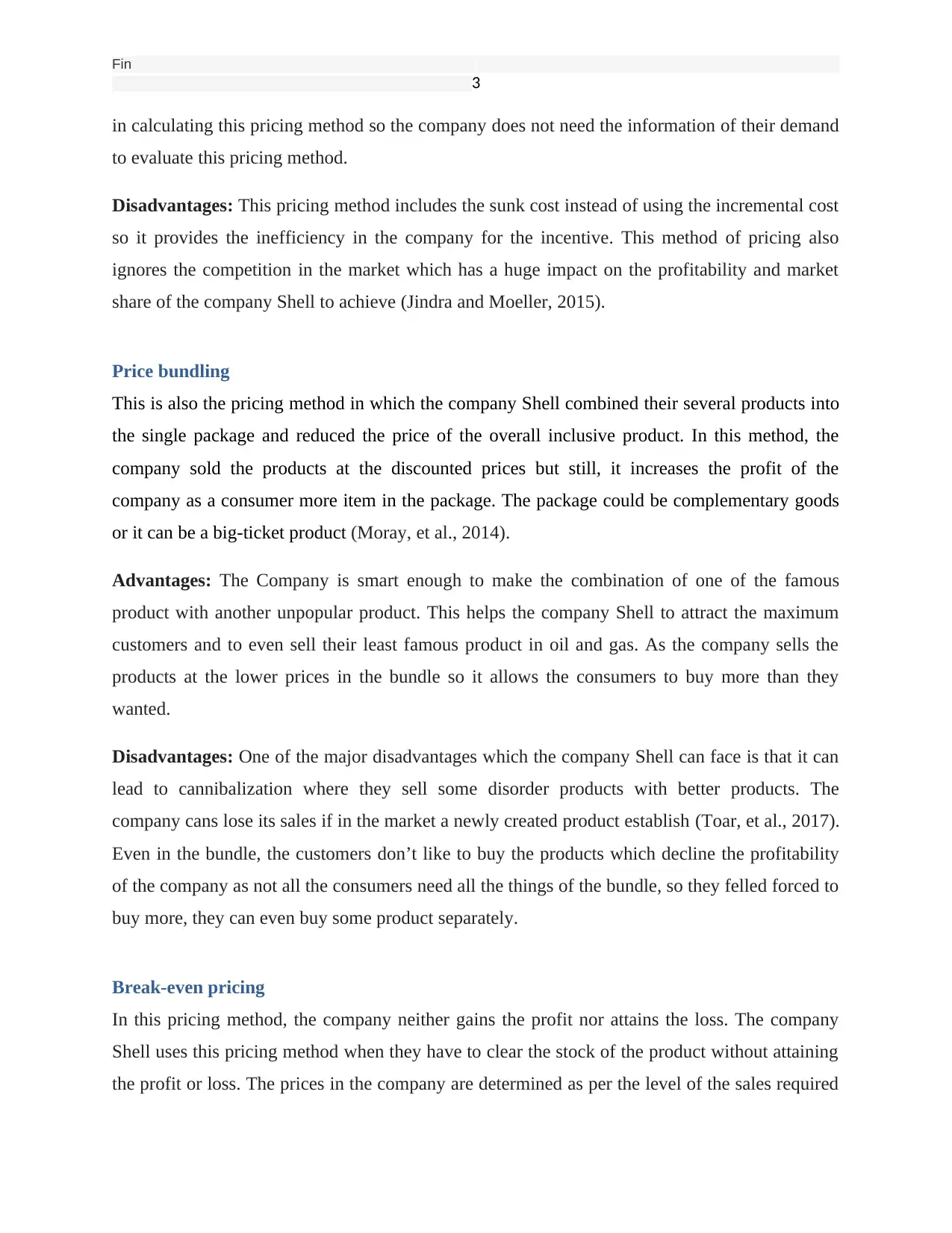
Fin
3
in calculating this pricing method so the company does not need the information of their demand
to evaluate this pricing method.
Disadvantages: This pricing method includes the sunk cost instead of using the incremental cost
so it provides the inefficiency in the company for the incentive. This method of pricing also
ignores the competition in the market which has a huge impact on the profitability and market
share of the company Shell to achieve (Jindra and Moeller, 2015).
Price bundling
This is also the pricing method in which the company Shell combined their several products into
the single package and reduced the price of the overall inclusive product. In this method, the
company sold the products at the discounted prices but still, it increases the profit of the
company as a consumer more item in the package. The package could be complementary goods
or it can be a big-ticket product (Moray, et al., 2014).
Advantages: The Company is smart enough to make the combination of one of the famous
product with another unpopular product. This helps the company Shell to attract the maximum
customers and to even sell their least famous product in oil and gas. As the company sells the
products at the lower prices in the bundle so it allows the consumers to buy more than they
wanted.
Disadvantages: One of the major disadvantages which the company Shell can face is that it can
lead to cannibalization where they sell some disorder products with better products. The
company cans lose its sales if in the market a newly created product establish (Toar, et al., 2017).
Even in the bundle, the customers don’t like to buy the products which decline the profitability
of the company as not all the consumers need all the things of the bundle, so they felled forced to
buy more, they can even buy some product separately.
Break-even pricing
In this pricing method, the company neither gains the profit nor attains the loss. The company
Shell uses this pricing method when they have to clear the stock of the product without attaining
the profit or loss. The prices in the company are determined as per the level of the sales required
3
in calculating this pricing method so the company does not need the information of their demand
to evaluate this pricing method.
Disadvantages: This pricing method includes the sunk cost instead of using the incremental cost
so it provides the inefficiency in the company for the incentive. This method of pricing also
ignores the competition in the market which has a huge impact on the profitability and market
share of the company Shell to achieve (Jindra and Moeller, 2015).
Price bundling
This is also the pricing method in which the company Shell combined their several products into
the single package and reduced the price of the overall inclusive product. In this method, the
company sold the products at the discounted prices but still, it increases the profit of the
company as a consumer more item in the package. The package could be complementary goods
or it can be a big-ticket product (Moray, et al., 2014).
Advantages: The Company is smart enough to make the combination of one of the famous
product with another unpopular product. This helps the company Shell to attract the maximum
customers and to even sell their least famous product in oil and gas. As the company sells the
products at the lower prices in the bundle so it allows the consumers to buy more than they
wanted.
Disadvantages: One of the major disadvantages which the company Shell can face is that it can
lead to cannibalization where they sell some disorder products with better products. The
company cans lose its sales if in the market a newly created product establish (Toar, et al., 2017).
Even in the bundle, the customers don’t like to buy the products which decline the profitability
of the company as not all the consumers need all the things of the bundle, so they felled forced to
buy more, they can even buy some product separately.
Break-even pricing
In this pricing method, the company neither gains the profit nor attains the loss. The company
Shell uses this pricing method when they have to clear the stock of the product without attaining
the profit or loss. The prices in the company are determined as per the level of the sales required
Paraphrase This Document
Need a fresh take? Get an instant paraphrase of this document with our AI Paraphraser
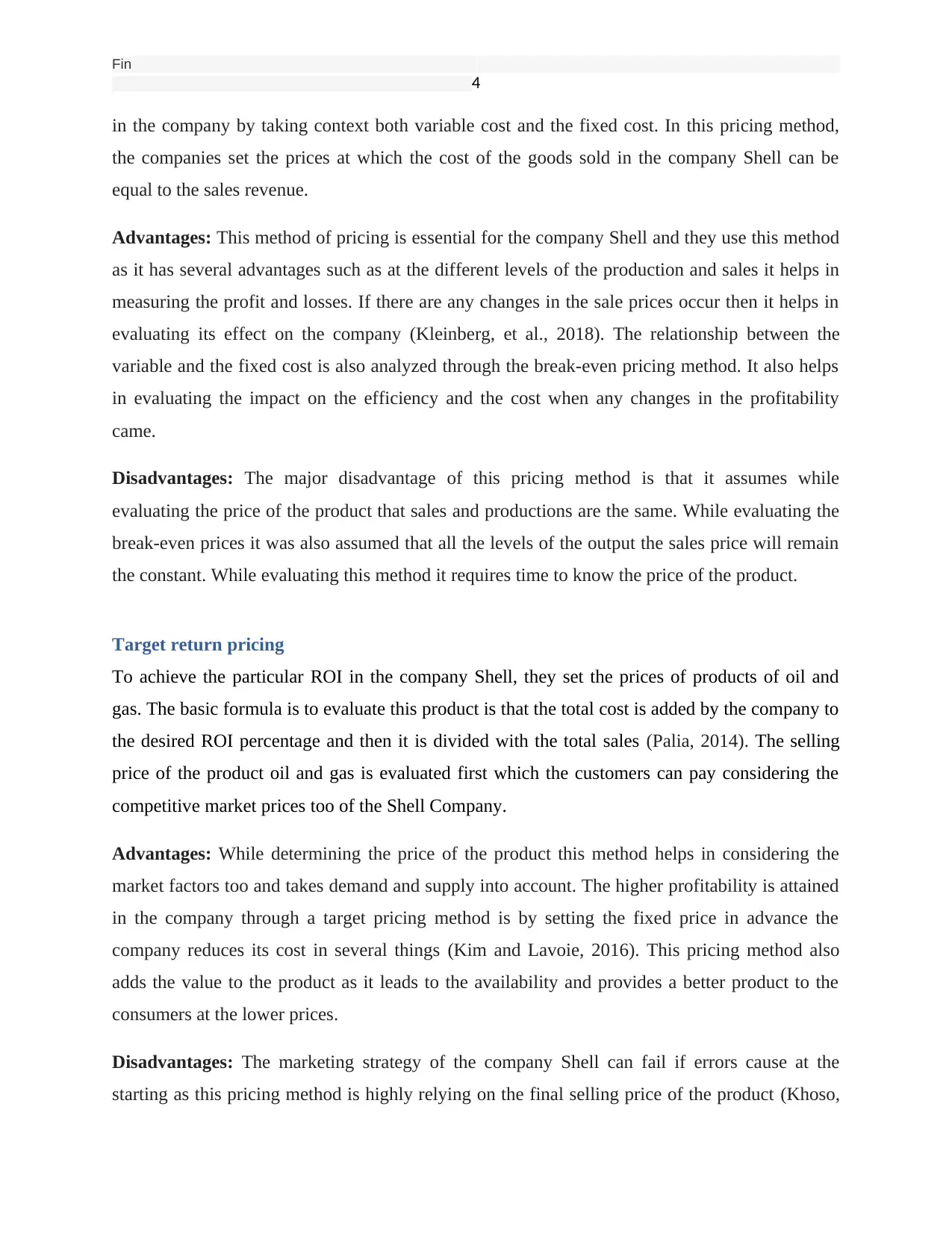
Fin
4
in the company by taking context both variable cost and the fixed cost. In this pricing method,
the companies set the prices at which the cost of the goods sold in the company Shell can be
equal to the sales revenue.
Advantages: This method of pricing is essential for the company Shell and they use this method
as it has several advantages such as at the different levels of the production and sales it helps in
measuring the profit and losses. If there are any changes in the sale prices occur then it helps in
evaluating its effect on the company (Kleinberg, et al., 2018). The relationship between the
variable and the fixed cost is also analyzed through the break-even pricing method. It also helps
in evaluating the impact on the efficiency and the cost when any changes in the profitability
came.
Disadvantages: The major disadvantage of this pricing method is that it assumes while
evaluating the price of the product that sales and productions are the same. While evaluating the
break-even prices it was also assumed that all the levels of the output the sales price will remain
the constant. While evaluating this method it requires time to know the price of the product.
Target return pricing
To achieve the particular ROI in the company Shell, they set the prices of products of oil and
gas. The basic formula is to evaluate this product is that the total cost is added by the company to
the desired ROI percentage and then it is divided with the total sales (Palia, 2014). The selling
price of the product oil and gas is evaluated first which the customers can pay considering the
competitive market prices too of the Shell Company.
Advantages: While determining the price of the product this method helps in considering the
market factors too and takes demand and supply into account. The higher profitability is attained
in the company through a target pricing method is by setting the fixed price in advance the
company reduces its cost in several things (Kim and Lavoie, 2016). This pricing method also
adds the value to the product as it leads to the availability and provides a better product to the
consumers at the lower prices.
Disadvantages: The marketing strategy of the company Shell can fail if errors cause at the
starting as this pricing method is highly relying on the final selling price of the product (Khoso,
4
in the company by taking context both variable cost and the fixed cost. In this pricing method,
the companies set the prices at which the cost of the goods sold in the company Shell can be
equal to the sales revenue.
Advantages: This method of pricing is essential for the company Shell and they use this method
as it has several advantages such as at the different levels of the production and sales it helps in
measuring the profit and losses. If there are any changes in the sale prices occur then it helps in
evaluating its effect on the company (Kleinberg, et al., 2018). The relationship between the
variable and the fixed cost is also analyzed through the break-even pricing method. It also helps
in evaluating the impact on the efficiency and the cost when any changes in the profitability
came.
Disadvantages: The major disadvantage of this pricing method is that it assumes while
evaluating the price of the product that sales and productions are the same. While evaluating the
break-even prices it was also assumed that all the levels of the output the sales price will remain
the constant. While evaluating this method it requires time to know the price of the product.
Target return pricing
To achieve the particular ROI in the company Shell, they set the prices of products of oil and
gas. The basic formula is to evaluate this product is that the total cost is added by the company to
the desired ROI percentage and then it is divided with the total sales (Palia, 2014). The selling
price of the product oil and gas is evaluated first which the customers can pay considering the
competitive market prices too of the Shell Company.
Advantages: While determining the price of the product this method helps in considering the
market factors too and takes demand and supply into account. The higher profitability is attained
in the company through a target pricing method is by setting the fixed price in advance the
company reduces its cost in several things (Kim and Lavoie, 2016). This pricing method also
adds the value to the product as it leads to the availability and provides a better product to the
consumers at the lower prices.
Disadvantages: The marketing strategy of the company Shell can fail if errors cause at the
starting as this pricing method is highly relying on the final selling price of the product (Khoso,
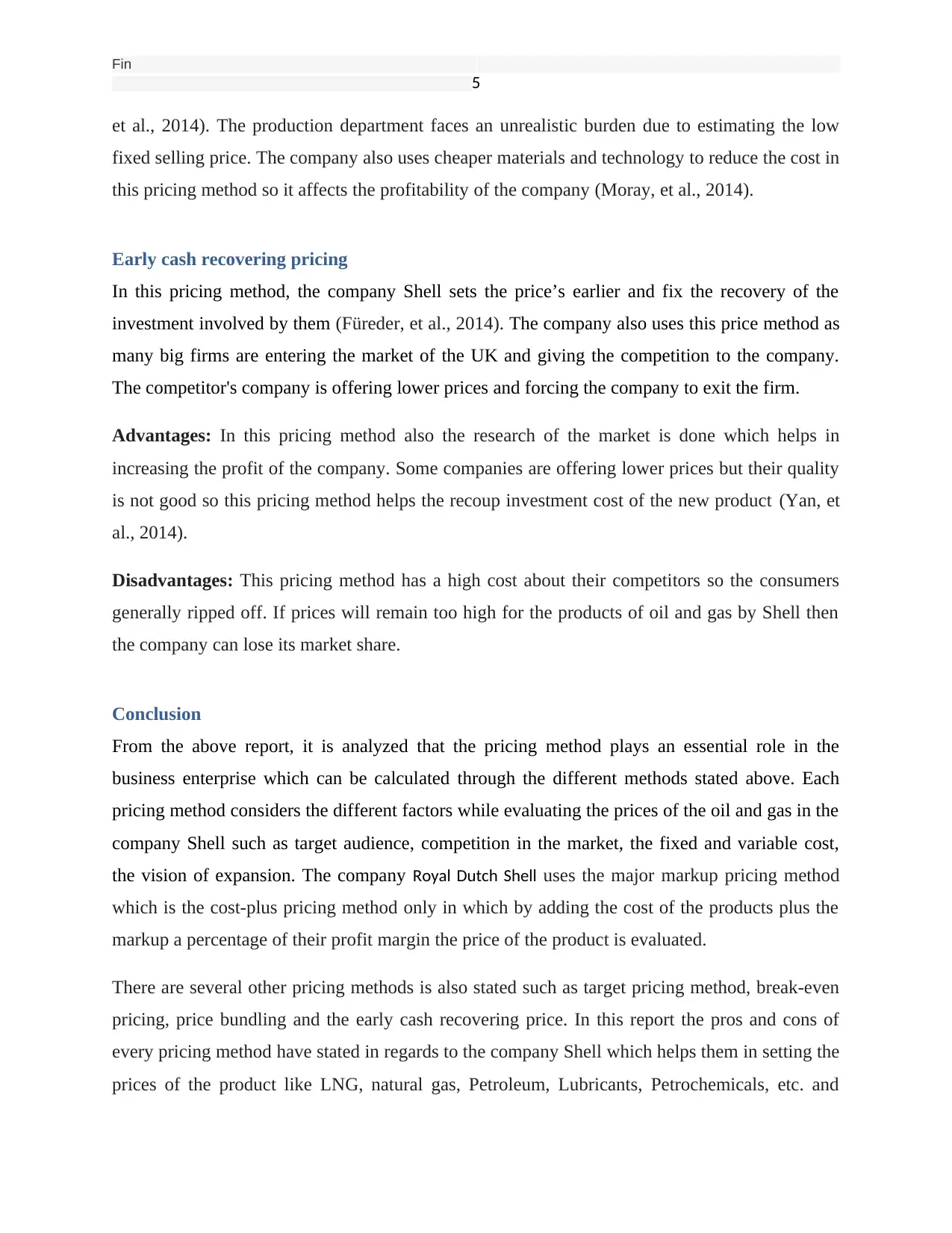
Fin
5
et al., 2014). The production department faces an unrealistic burden due to estimating the low
fixed selling price. The company also uses cheaper materials and technology to reduce the cost in
this pricing method so it affects the profitability of the company (Moray, et al., 2014).
Early cash recovering pricing
In this pricing method, the company Shell sets the price’s earlier and fix the recovery of the
investment involved by them (Füreder, et al., 2014). The company also uses this price method as
many big firms are entering the market of the UK and giving the competition to the company.
The competitor's company is offering lower prices and forcing the company to exit the firm.
Advantages: In this pricing method also the research of the market is done which helps in
increasing the profit of the company. Some companies are offering lower prices but their quality
is not good so this pricing method helps the recoup investment cost of the new product (Yan, et
al., 2014).
Disadvantages: This pricing method has a high cost about their competitors so the consumers
generally ripped off. If prices will remain too high for the products of oil and gas by Shell then
the company can lose its market share.
Conclusion
From the above report, it is analyzed that the pricing method plays an essential role in the
business enterprise which can be calculated through the different methods stated above. Each
pricing method considers the different factors while evaluating the prices of the oil and gas in the
company Shell such as target audience, competition in the market, the fixed and variable cost,
the vision of expansion. The company Royal Dutch Shell uses the major markup pricing method
which is the cost-plus pricing method only in which by adding the cost of the products plus the
markup a percentage of their profit margin the price of the product is evaluated.
There are several other pricing methods is also stated such as target pricing method, break-even
pricing, price bundling and the early cash recovering price. In this report the pros and cons of
every pricing method have stated in regards to the company Shell which helps them in setting the
prices of the product like LNG, natural gas, Petroleum, Lubricants, Petrochemicals, etc. and
5
et al., 2014). The production department faces an unrealistic burden due to estimating the low
fixed selling price. The company also uses cheaper materials and technology to reduce the cost in
this pricing method so it affects the profitability of the company (Moray, et al., 2014).
Early cash recovering pricing
In this pricing method, the company Shell sets the price’s earlier and fix the recovery of the
investment involved by them (Füreder, et al., 2014). The company also uses this price method as
many big firms are entering the market of the UK and giving the competition to the company.
The competitor's company is offering lower prices and forcing the company to exit the firm.
Advantages: In this pricing method also the research of the market is done which helps in
increasing the profit of the company. Some companies are offering lower prices but their quality
is not good so this pricing method helps the recoup investment cost of the new product (Yan, et
al., 2014).
Disadvantages: This pricing method has a high cost about their competitors so the consumers
generally ripped off. If prices will remain too high for the products of oil and gas by Shell then
the company can lose its market share.
Conclusion
From the above report, it is analyzed that the pricing method plays an essential role in the
business enterprise which can be calculated through the different methods stated above. Each
pricing method considers the different factors while evaluating the prices of the oil and gas in the
company Shell such as target audience, competition in the market, the fixed and variable cost,
the vision of expansion. The company Royal Dutch Shell uses the major markup pricing method
which is the cost-plus pricing method only in which by adding the cost of the products plus the
markup a percentage of their profit margin the price of the product is evaluated.
There are several other pricing methods is also stated such as target pricing method, break-even
pricing, price bundling and the early cash recovering price. In this report the pros and cons of
every pricing method have stated in regards to the company Shell which helps them in setting the
prices of the product like LNG, natural gas, Petroleum, Lubricants, Petrochemicals, etc. and
⊘ This is a preview!⊘
Do you want full access?
Subscribe today to unlock all pages.

Trusted by 1+ million students worldwide
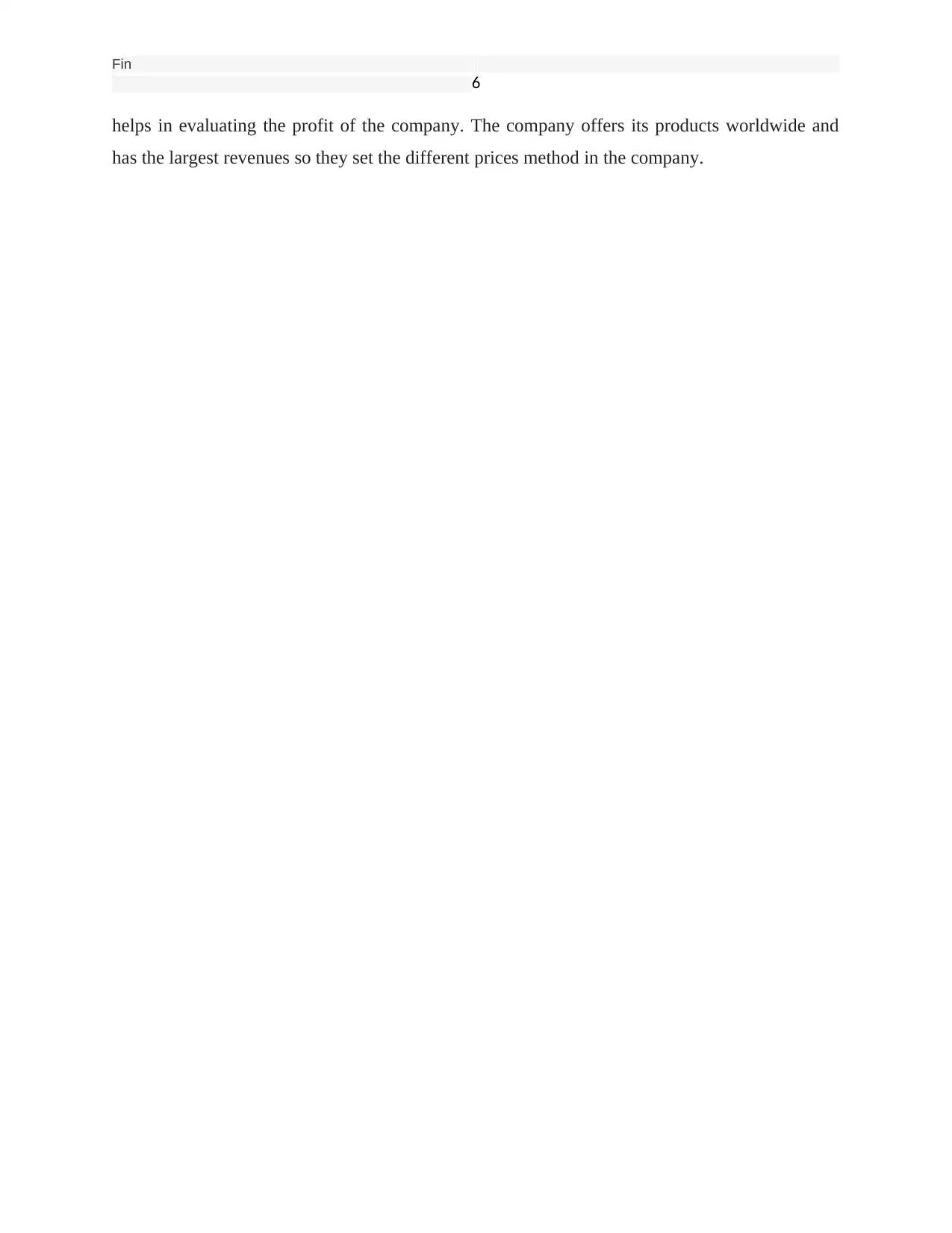
Fin
6
helps in evaluating the profit of the company. The company offers its products worldwide and
has the largest revenues so they set the different prices method in the company.
6
helps in evaluating the profit of the company. The company offers its products worldwide and
has the largest revenues so they set the different prices method in the company.
Paraphrase This Document
Need a fresh take? Get an instant paraphrase of this document with our AI Paraphraser
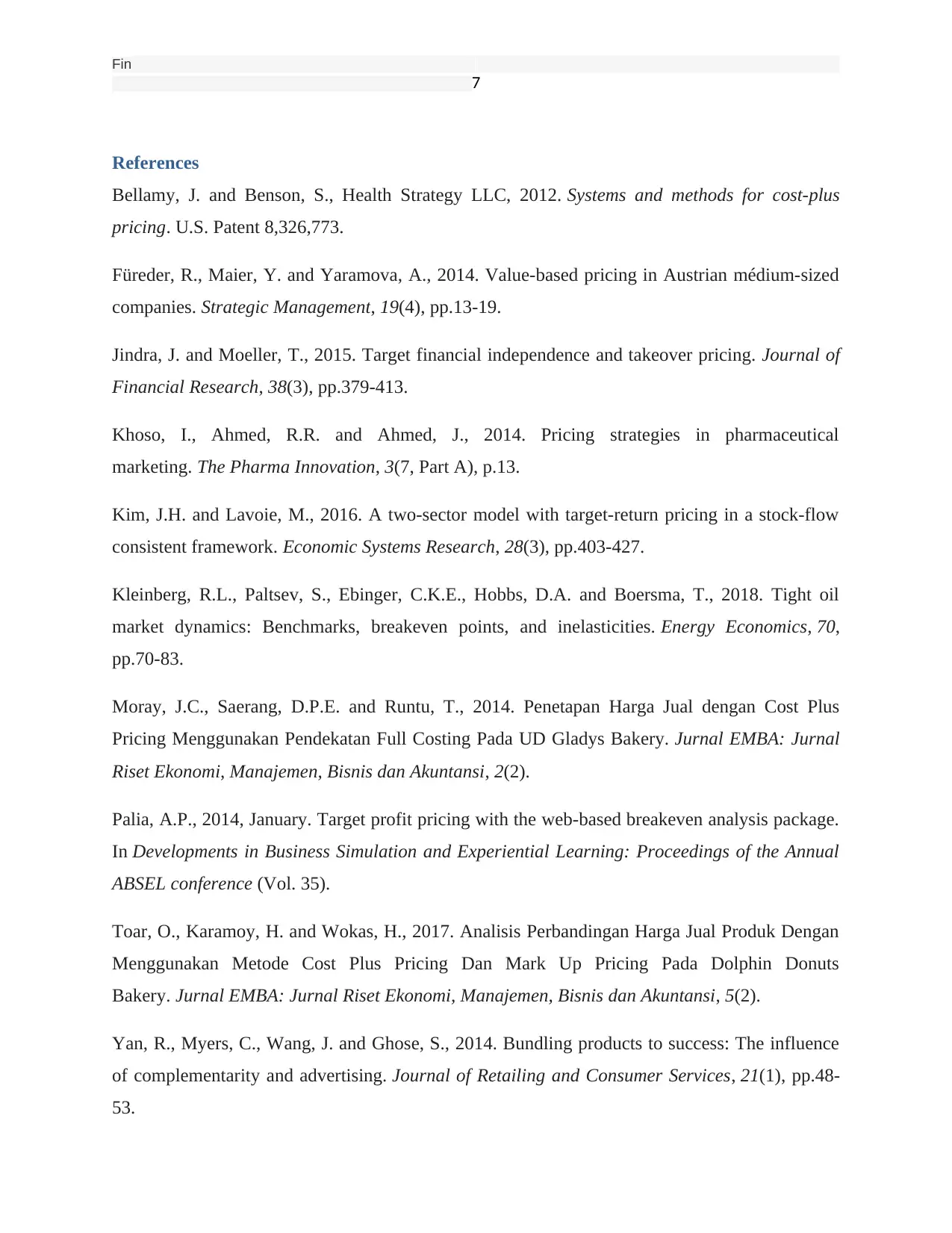
Fin
7
References
Bellamy, J. and Benson, S., Health Strategy LLC, 2012. Systems and methods for cost-plus
pricing. U.S. Patent 8,326,773.
Füreder, R., Maier, Y. and Yaramova, A., 2014. Value-based pricing in Austrian médium-sized
companies. Strategic Management, 19(4), pp.13-19.
Jindra, J. and Moeller, T., 2015. Target financial independence and takeover pricing. Journal of
Financial Research, 38(3), pp.379-413.
Khoso, I., Ahmed, R.R. and Ahmed, J., 2014. Pricing strategies in pharmaceutical
marketing. The Pharma Innovation, 3(7, Part A), p.13.
Kim, J.H. and Lavoie, M., 2016. A two-sector model with target-return pricing in a stock-flow
consistent framework. Economic Systems Research, 28(3), pp.403-427.
Kleinberg, R.L., Paltsev, S., Ebinger, C.K.E., Hobbs, D.A. and Boersma, T., 2018. Tight oil
market dynamics: Benchmarks, breakeven points, and inelasticities. Energy Economics, 70,
pp.70-83.
Moray, J.C., Saerang, D.P.E. and Runtu, T., 2014. Penetapan Harga Jual dengan Cost Plus
Pricing Menggunakan Pendekatan Full Costing Pada UD Gladys Bakery. Jurnal EMBA: Jurnal
Riset Ekonomi, Manajemen, Bisnis dan Akuntansi, 2(2).
Palia, A.P., 2014, January. Target profit pricing with the web-based breakeven analysis package.
In Developments in Business Simulation and Experiential Learning: Proceedings of the Annual
ABSEL conference (Vol. 35).
Toar, O., Karamoy, H. and Wokas, H., 2017. Analisis Perbandingan Harga Jual Produk Dengan
Menggunakan Metode Cost Plus Pricing Dan Mark Up Pricing Pada Dolphin Donuts
Bakery. Jurnal EMBA: Jurnal Riset Ekonomi, Manajemen, Bisnis dan Akuntansi, 5(2).
Yan, R., Myers, C., Wang, J. and Ghose, S., 2014. Bundling products to success: The influence
of complementarity and advertising. Journal of Retailing and Consumer Services, 21(1), pp.48-
53.
7
References
Bellamy, J. and Benson, S., Health Strategy LLC, 2012. Systems and methods for cost-plus
pricing. U.S. Patent 8,326,773.
Füreder, R., Maier, Y. and Yaramova, A., 2014. Value-based pricing in Austrian médium-sized
companies. Strategic Management, 19(4), pp.13-19.
Jindra, J. and Moeller, T., 2015. Target financial independence and takeover pricing. Journal of
Financial Research, 38(3), pp.379-413.
Khoso, I., Ahmed, R.R. and Ahmed, J., 2014. Pricing strategies in pharmaceutical
marketing. The Pharma Innovation, 3(7, Part A), p.13.
Kim, J.H. and Lavoie, M., 2016. A two-sector model with target-return pricing in a stock-flow
consistent framework. Economic Systems Research, 28(3), pp.403-427.
Kleinberg, R.L., Paltsev, S., Ebinger, C.K.E., Hobbs, D.A. and Boersma, T., 2018. Tight oil
market dynamics: Benchmarks, breakeven points, and inelasticities. Energy Economics, 70,
pp.70-83.
Moray, J.C., Saerang, D.P.E. and Runtu, T., 2014. Penetapan Harga Jual dengan Cost Plus
Pricing Menggunakan Pendekatan Full Costing Pada UD Gladys Bakery. Jurnal EMBA: Jurnal
Riset Ekonomi, Manajemen, Bisnis dan Akuntansi, 2(2).
Palia, A.P., 2014, January. Target profit pricing with the web-based breakeven analysis package.
In Developments in Business Simulation and Experiential Learning: Proceedings of the Annual
ABSEL conference (Vol. 35).
Toar, O., Karamoy, H. and Wokas, H., 2017. Analisis Perbandingan Harga Jual Produk Dengan
Menggunakan Metode Cost Plus Pricing Dan Mark Up Pricing Pada Dolphin Donuts
Bakery. Jurnal EMBA: Jurnal Riset Ekonomi, Manajemen, Bisnis dan Akuntansi, 5(2).
Yan, R., Myers, C., Wang, J. and Ghose, S., 2014. Bundling products to success: The influence
of complementarity and advertising. Journal of Retailing and Consumer Services, 21(1), pp.48-
53.
1 out of 8
Related Documents
Your All-in-One AI-Powered Toolkit for Academic Success.
+13062052269
info@desklib.com
Available 24*7 on WhatsApp / Email
![[object Object]](/_next/static/media/star-bottom.7253800d.svg)
Unlock your academic potential
Copyright © 2020–2025 A2Z Services. All Rights Reserved. Developed and managed by ZUCOL.




